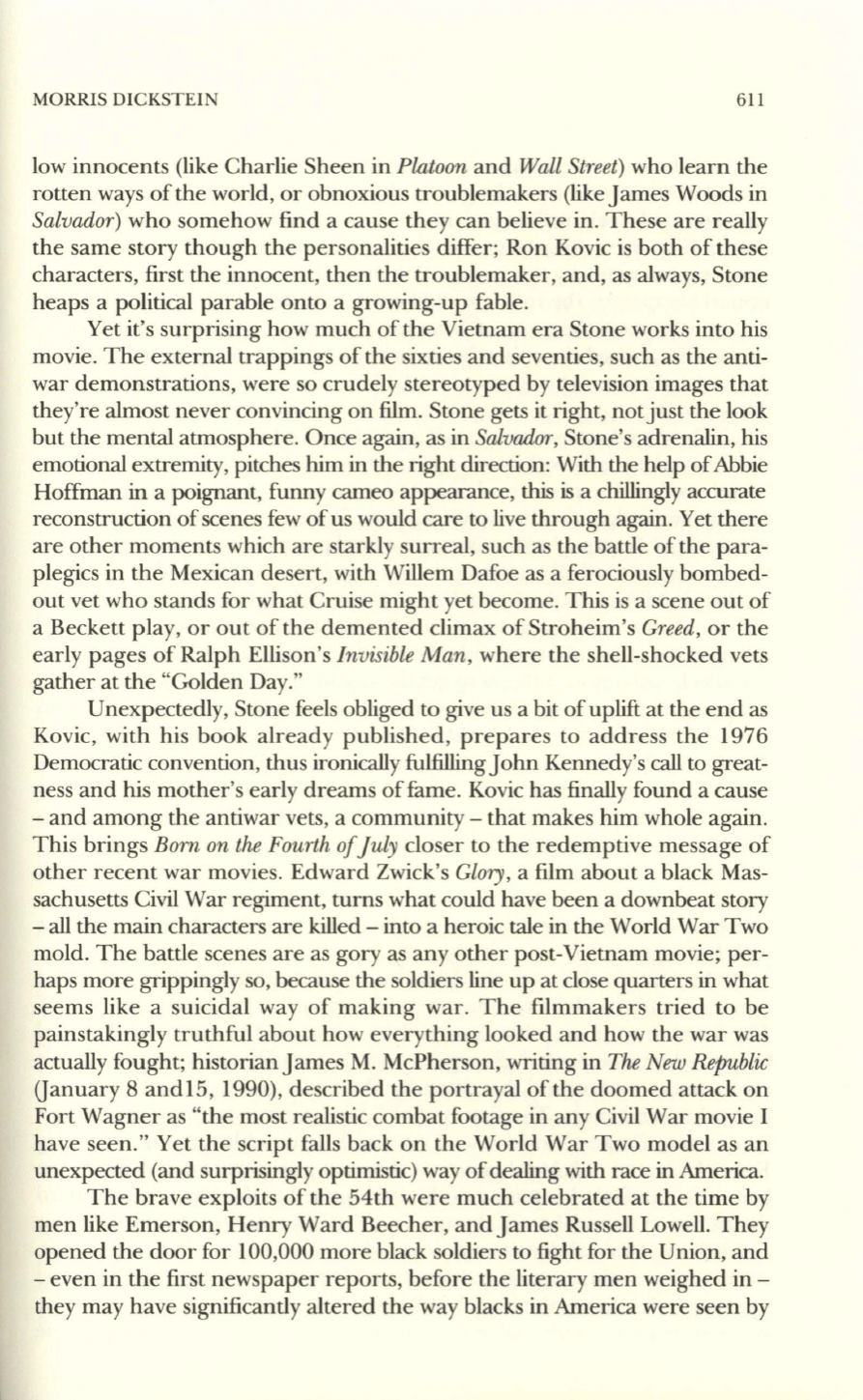
MORRIS DICKSTEIN
611
low innocents (like Charlie Sheen in
Platoon
and
Wall Street)
who learn the
rotten ways of the world, or obnoxious troublemakers (like James Woods in
Salvador)
who somehow find a cause they can believe in. These are really
the same story though the personalities differ; Ron Kovic is both of these
characters, first the innocent, then the troublemaker, and, as always, Stone
heaps a political parable onto a growing-up fable.
Yet it's surprising how much of the Vietnam era Stone works into his
movie. The external trappings of the sixties and seventies, such as the anti–
war demonstrations, were so crudely stereotyped by television images that
they're almost never convincing on film. Stone gets it right, not just the look
but the mental atmosphere. Once again, as in
Salvador,
Stone's adrenalin, his
emotional extremity, pitches
him
in the right direction: With the help ofAbbie
Hoffman
in
a poignant, funny cameo appearance,
this
is a chillingly accurate
reconstruction of scenes few of us would care to live through again. Yet there
are other moments which are starkly surreal, such as the battle of the para–
plegics in the Mexican desert, with Willem Dafoe as a ferociously bombed–
out vet who stands for what Cruise might yet become. This is a scene out of
a Beckett play, or out of the demented climax of Stroheim's
Greed,
or the
early pages of Ralph Ellison's
Invisible Man,
where the shell-shocked vets
gather at the "Golden Day."
Unexpectedly, Stone feels obliged to give us a bit of uplift at the end as
Kovic, with his book already published, prepares to address the 1976
Democratic convention, thus ironically fulfilling John Kennedy's
call
to great–
ness and his mother's early dreams of fame. Kovic has finally found a cause
- and among the antiwar vets, a community - that makes him whole again.
This brings
Born on the Fourth ofJuly
closer to the redemptive message of
other recent war movies. Edward Zwick's
Glory,
a film about a black Mas–
sachusetts Civil War regiment, turns what could have been a downbeat story
- all the main characters are killed - into a heroic tale in the World War Two
mold. The battle scenes are as gory as any other post-Vietnam movie; per–
haps more grippingly so, because the soldiers line up at close quarters in what
seems like a suicidal way of making war. The filmmakers tried to be
painstakingly truthful about how everything looked and how the war was
actually fought; historian James M. McPherson, writing in
The New Republic
(January 8 andIS, 1990), described the portrayal ofthe doomed attack on
Fort Wagner as "the most realistic combat footage in any Civil War movie I
have seen." Yet the script falls back on the World War Two model as an
unexpected (and surprisingly optimistic) way of dealing with race in America.
The brave exploits of the 54th were much celebrated at the time by
men like Emerson, Henry Ward Beecher, and James Russell Lowell. They
opened the door for 100,000 more black soldiers to fight for the Union, and
- even in the first newspaper reports, before the literary men weighed in -
they may have significantly altered the way blacks in America were seen by


